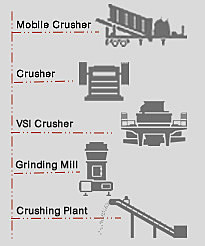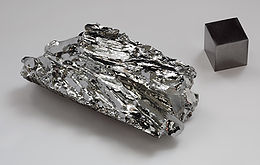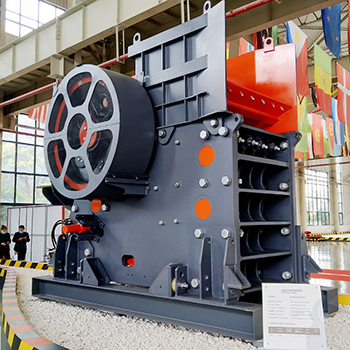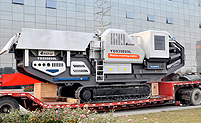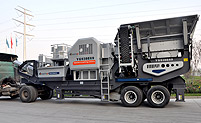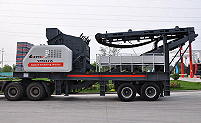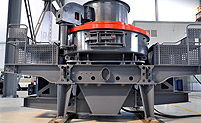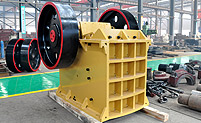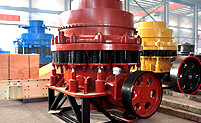Molybdenum ore crusher
Molybdenum ( /ˌmɒlɪbˈdiːnəm/ MOL-ib-DEE-nəm or /məˈlɪbdɪnəm/ mə-LIB-di-nəm), is a Group 6 chemical element with the symbol Mo and atomic number 42. The name is from Neo-Latin Molybdaenum, from Ancient Greek Μόλυβδος molybdos, meaning lead, since its ores were confused with lead ores. The free element, which is a silvery metal, has the sixth-highest melting point of any element. It readily forms hard, stable carbides, and for this reason it is often used in high-strength steel alloys. Molybdenum does not occur as the free metal in nature, but rather in various oxidation states in minerals. Industrially, molybdenum compounds are used in high pressure and high temperature applications, as pigments and catalysts.
Molybdenum minerals have long been known, but the element was "discovered" (in the s
ense of differentiating it as a new entity from minerals salts of other metals) in 1778 by Carl Wilhelm Scheele. The metal was first isolated in 1781 by Peter Jacob Hjelm.
Most molybdenum compounds have low solubility in water, but the molybdate ion MoO42− is soluble and will form if molybdenum-containing minerals are in contact with oxygen and water. Recent theories suggest that the release of oxygen by early life was important in removing molybdenum from minerals into a soluble form in the early oceans, where it was used as a catalyst by single-celled organisms. This sequence may have been important in the history of life, because molybdenum-containing enzymes then became the most important catalysts used by some bacteria to break the chemical bond in atmospheric molecular nitrogen, allowing biological nitrogen fixation. This, in turn allowed biologically driven nitrogen-fertilization of the oceans, and thus the development of more complex organisms.
At least 50 molybdenum-containing enzymes are now known in bacteria and animals, though only the bacterial and cyanobacterial enzymes are involved in nitrogen fixation. Due to the diverse functions of the remainder of the enzymes, molybdenum is a required element for life in higher organisms (eukaryotes), though not in all bacteria.
Applications Alloys
The ability of molybdenum to withstand extreme temperatures without significantly expanding or softening makes it useful in applications that involve intense heat, including the manufacture of aircraft parts, electrical contacts, industrial motors and filaments.
Most high-strength steel alloys (example 41xx steels) contain 0.25% to 8% molybdenum. Despite such small portions, more than 43,000 tonnes of molybdenum are used as an alloying agent each year in stainless steels, tool steels, cast irons and high-temperature superalloys.
Molybdenum is also used in steel alloys for its high corrosion resistance and weldability. Molybdenum contributes further corrosion resistance to "chrome-moly" type-300 stainless steels (high-chromium steels that are corrosion-resistant already due to their chromium content) and especially so in the so-called superaustenitic stainless steels (such as alloy AL-6XN). Molybdenum acts by increasing lattice strain, thus increasing the energy required to dissolve out iron atoms from the surface.
Kenya is a country which is rich in mineral resources, such as copper,iron, titanium, manganese, gold, and so on. When you want the exploitation of mineral stone, there are many choices. But we provide you with the best combination, improve efficiency and reduce energy Consumption, and we provide mobility to facilitate the migration of the broken program , such as portable crushing plant or mobile crushing plant.
The best crusher combination for molybdenum :
jaw crusher, jc jaw crusher, hp cone crusher, pfw impact crusher
Because of its lower density and more stable price, molybdenum is sometimes used instead of tungsten. An example is the 'M' series of high-speed steels such as M2, M4 and M42 as substitution for the 'T' steel series which contain tungsten. Molybdenum can be implemented both as an alloying agent and as a flame-resistant coating for other metals. Although its melting point is 2,623 °C (4,753 °F), molybdenum rapidly oxidizes at temperatures above 760 °C (1,400 °F) making it better-suited for use in vacuum environments.
TZM (Mo (~99%), Ti (~0.5%), Zr (~0.08%) and some C) is a corrosion resisting molybdenum superalloy that resists molten fluoride salts at temperatures above 1300C. It has about twice the strength of pure Mo, and is more ductile and more weldable, yet in tests it resisted corrosion of a standard eutectic salt (FLiBe) and salt vapors used in molten salt reactors for 1100 hours with so little corrosion that it was difficult to measure.
Other molybdenum-based alloys which do not contain iron have only limited applications. For example, because of the corrosion resistance against molten zinc, both pure molybdenum and the molybdenum/tungsten alloy (70%/30%) are used for piping, stirrers and pump impellers which come into contact with molten zinc.
PrevPage: Limonite crusher
Next Page: Graphite Crusher

